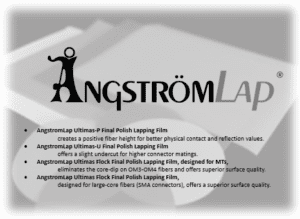Two of the most frequently asked questions from fiber optic cable assembly operations are:
- “How do scratches appear?”
- “How can we keep scratches to a minimum?”
When we receive these questions from a customer, we usually request a visual image of one or more scratches as well as geometry measurements of the connectors. With this information, we try to understand the mechanical parameters applied to the film and connector. This includes various aspects of the entire lapping film operation: the polisher, lapping films, time, pressure, rotation speed, stability, applied fluids, cleaning procedures, and so forth.
Why such a thorough investigation? Because scratches might relate to issues in earlier steps in the assembly process. For example, epoxy application, epoxy mixing and/or outgassing, the curing schedule, and encapsulated humidity are common – and surprising – root causes for seeing scratches with a final film. Also, the cleaning operation of the lapping films, connectors, and polishing fixture between polishing steps is often detected as a root cause for scratch generation. In fact, so-called “cross contamination” is common when rough lapping film debris isn’t thoroughly removed when starting with a finer grit abrasive film. (We recommend cost-effective silica carbide abrasive films for excess epoxy removal, followed by a finer grit abrasive film to establish a perfect geometry.)
Once we’ve established that the assembly house has a stable lapping film process, we look at the roughness and uniformity of the batch. The visual inspection should show uniform roughness at the typical 0.5-micron or 1-micron level. If the surface roughness isn’t uniform, it likely is caused by one of the example issues mentioned above.
Once a uniform batch of connectors or fibers is achieved, as a starting point, we introduce the final film under the same mechanical parameters as the last abrasive film. As the ÅngströmLap Ultimas Final Polishing Lapping Film deposits its silicon dioxide material on the fiber/ferrule surface, it performs an entirely different chemical reaction than the abrasive films. The silica deposition forms a “coating” over the surface, which offers superior reflection.

The four different versions of ÅngströmLap Ultimas Final Polish Lapping Film (Ultimas-P, Ultimas-U and two Ultimas Flock versions) can address multiple requirements and needs.
Here is a very brief overview of the different types of ÅngströmLap Ultimas Final Polish Lapping Films:
- ÅngströmLap Ultimas-P Final Polish Lapping Film creates a positive fiber height for better physical contact and reflection values.
- ÅngströmLap Ultimas-U Final Polish Lapping Film offers a slight undercut for higher connector matings.
- ÅngströmLap Ultimas Flock Final Polish Lapping Film, designed for MTs, eliminates the core-dip on OM3-OM4 fibers and offers superior surface quality.
- ÅngströmLap Ultimas Flock Final Polish Lapping Film, designed for large-core fibers (SMA connectors), offers a superior surface quality.
Again, when scratches appear after using the final film, this typically relates back to earlier operational steps. It’s important to isolate and correct problematic issues throughout the assembly process. At Fiber Optic Center, we developed the ÅngströmLap Final Polish Lapping Film and fine-tuned the polishing process for fiber optic connectors.
If you have questions about your polishing process, we encourage you to contact us. You can email your question to AskFOC@focenter.com – one of our technical experts will respond as soon as possible. Our goal is to help you make the best fiber optic cable assemblies in the world.
The FOC Lapping Film Technical Resources webpage can be bookmarked at: focenter.com/lapping-film-consumables// that includes downloads and links on polishing processes, quick links to products and the fiber optic glossary.
We invite you to learn more:
- View FOC lapping film products
- Steps to Overcome Common APC Polishing Issues
- How to Develop a Fiber Optic Polishing Process that Produces Consistent Results
- APC Polishing Advice to Improve Apex Offset and Angle Measurements
- Why Isn’t There One Standard Polishing Procedure?
- Why Use ÅngströmLap Lapping Film Over Other Manufacturers?
- Using Chemical Mechanical Planarization (CMP) to Polish MT Ferrules and Get Repeatable, Predictable Results



